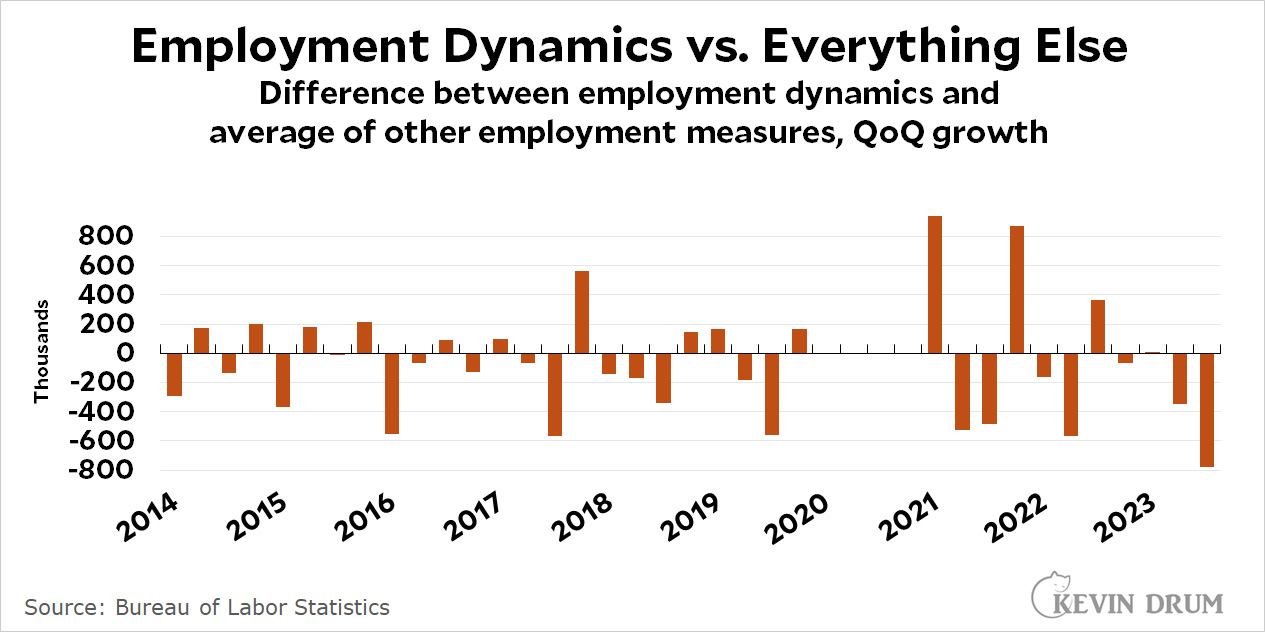I noticed something odd yesterday. There are many different ways of estimating the net number of new jobs each quarter, and one of the least known is the quarterly BLS report on employment dynamics. It measures the number of jobs gained from businesses opening or expanding minus the number of jobs lost from businesses closing or contracting. Put them together and you get the net number of new jobs.
This figure is always way behind: yesterday's number was for Q3 of last year. What was odd is that it says we lost 192,000 jobs that quarter. The other primary sources of employment data all agree that we added 500-700,000 jobs.
This is probably not too big a deal. These figures diverge all the time, partly because of statistical noise and partly because they don't measure precisely the same things. However, this is the second quarter in a row it's happened, and it's the biggest negative divergence in the past decade:
 It's worth noting that the low employment dynamics number is not because businesses are letting more people go. It's specifically because many fewer businesses are opening or expanding. That number has declined by more than a million jobs over the past year.
It's worth noting that the low employment dynamics number is not because businesses are letting more people go. It's specifically because many fewer businesses are opening or expanding. That number has declined by more than a million jobs over the past year.
I suppose this doesn't mean anything. It's probably just one of those oddities that crops up from time to time. But it does make me wonder if maybe we're not creating as many jobs as we think.
UPDATE: I've changed the chart to show to show the actual difference, not the percentage difference. It gives a better idea of what the divergence really looks like.

My spouse has been trying and failing to get a job in her field (pr/comm/marketing) since her previous employer folded in december. She has applied for many jobs and been rejected but the same job postings are still up months later. We currently believe most of these jobs are fake and they're only posted to meet some obscure government requirement.
(Also we are nearly out of unemployment so if anyone here has leads on a job or even freelance work we need it).
I am not an economist, but I'm having a hard time understanding how the US is generating any jobs at all.
Since the early eighties, the US has been running trade deficits with countries running trade surpluses. In particular, the Chinese government has been propping up its export industries in order to provide manufacturing jobs for its vast population. This has the effect of exporting the country's unemployment to its trading partners. If the Chinese are making steel and cars and low-cost products and China's trading partners are buying them, the trading partners are not making those products domestically.
The US has been absorbing this trade surplus and is the "beneficiary" of the exported unemployment for at least forty years. Which is about how long working-class wages have not risen in the US. How there are any new jobs at all in the US is a mystery to me.
I'm going to assume that the newly created US jobs are all YouTube influencers selling views to each other, at least until the music stops.
That trade deficit means that the US is consuming more than it produces. Given that the US economy is effectively at full employment, the US appears to be consuming more than it CAN produce. Under these circumstances, remedying the trade deficit would necessarily involve a decline in the average American's standard of living.
That assumes buying less "shit we dont need" if I may quote Fight Club, would lower the standard of living. I submit that it would not for a surprising number of people.
That, I suppose, depends on how you measure the standard of living.
Service industry jobs, ranging from low paid retail and hospitality to well paid healthcare and FIRE industry.
The chart indicates that over time the differences balance out; sometimes employment dynamics is lower, sometimes the other measures are lower.
Kevin has a bad habit of over-reducing numbers. In this case he first used percentage, then the difference, without the absolute numbers.
Why not just give the absolute numbers on the vertical scale? Using the difference reduces the information given to the reader.